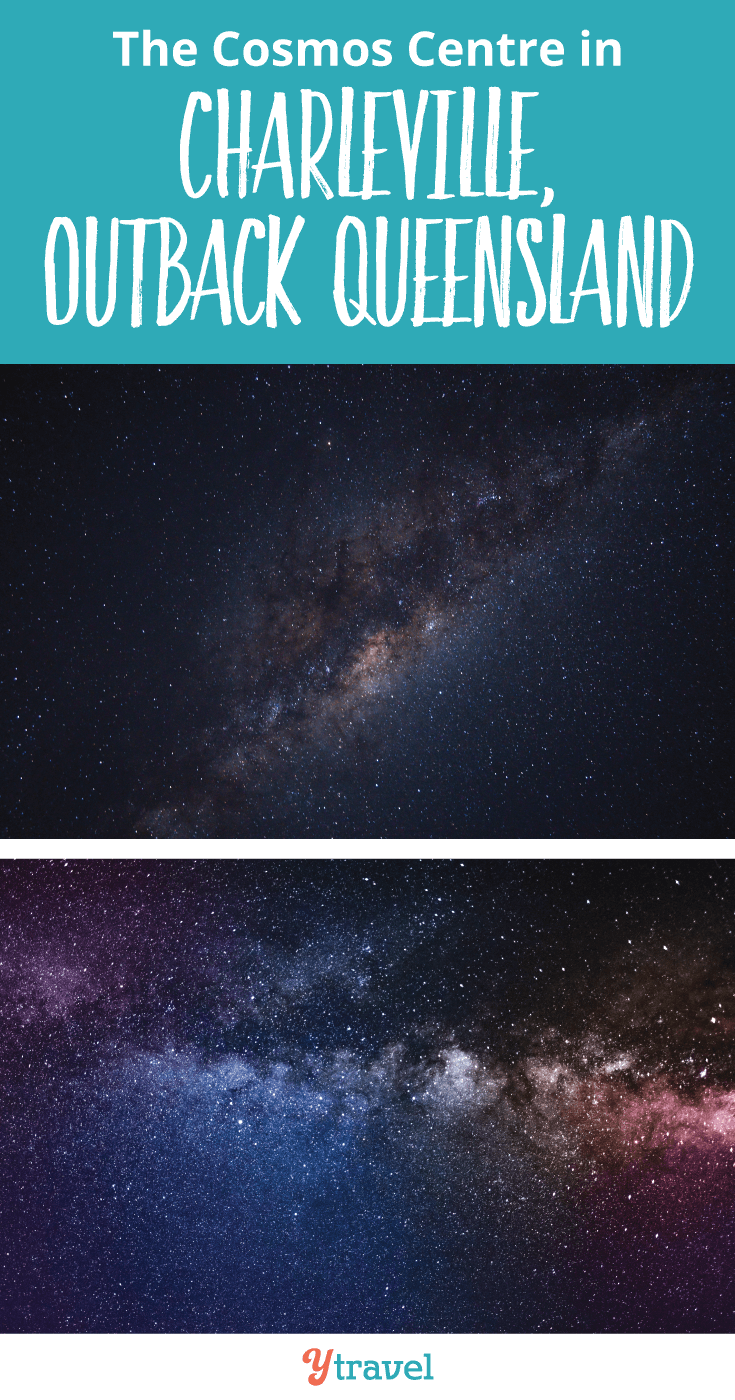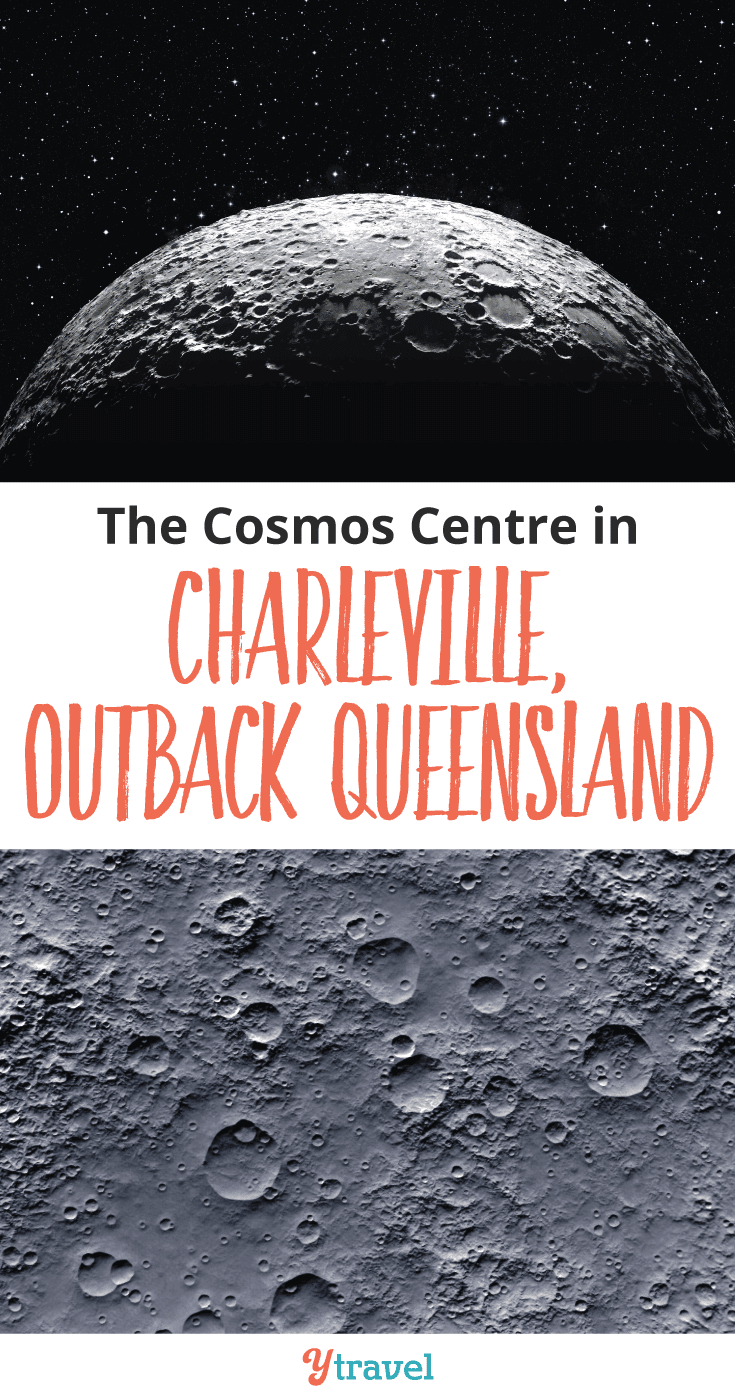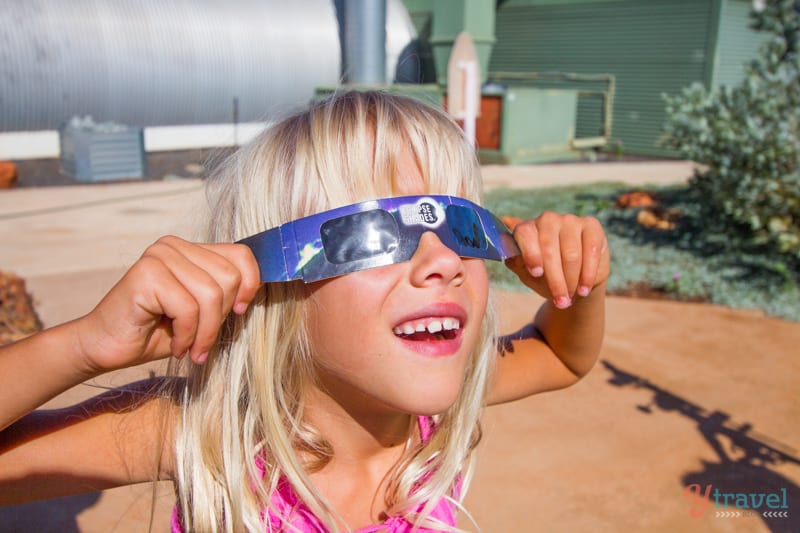This post may contain affiliate links. We may receive a small commission, at no cost to you, if you make a purchase. Read Disclosure.
Have you ever looked up at the night sky and wondered if there are aliens out there, or if your neighbour’s cat is harbouring a secret space ship?
If you’re looking to launch your astronomic curiosity into orbit, pay a visit to the Cosmos Centre Charleville in Outback Queensland!
The Cosmos Centre is the perfect place to learn about the night’s sky, with its engaging exhibits and hands-on astronomy workshops, the Cosmos Centre is the perfect place for stargazers.
Here’s what you can expect from your visit…
About Charleville Cosmos Centre
The Charleville Cosmos Centre is more than just a planetarium, it’s an experience.
This is Queensland’s largest planetarium, and the place to learn about planets, star constellations, and the science of the universe in a fun and engaging way.
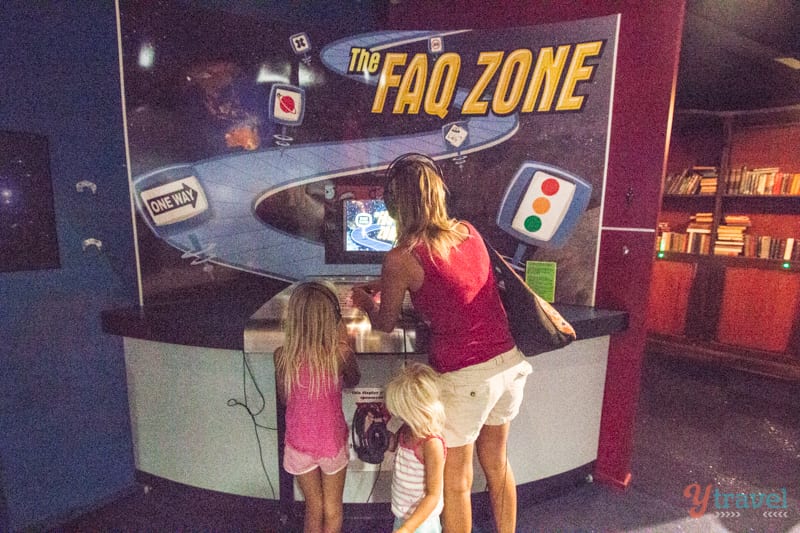
The program is designed for all ages. Our kids loved the storytelling, which made education seem exciting and enjoyable.
They offer both day and night viewing, show planetarium films, and use the most advanced telescopes to view celestial objects, star clusters, binary stars, thousands of light years away!
Through the combination of education and passion for discoveries, this is the best place to get an understanding of the universe and our place in the solar system.
Visiting the Cosmos Centre in Charleville
Day Experience
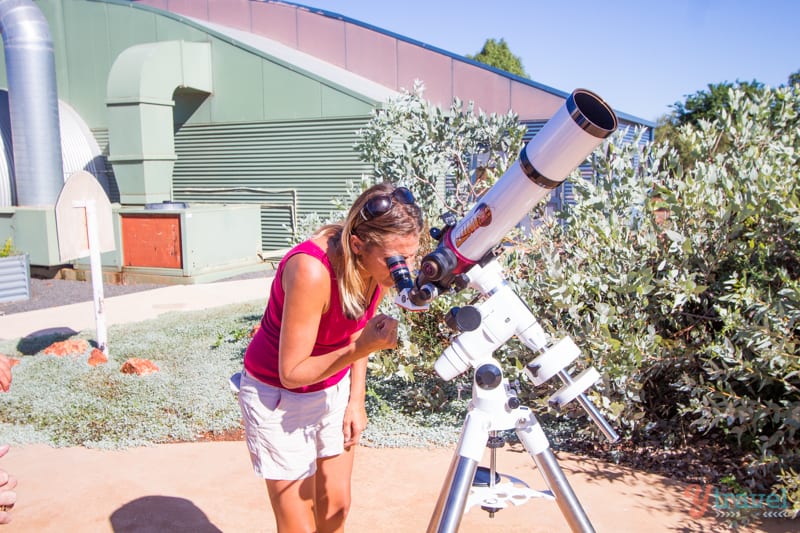
Our first experience at the Charleville Cosmos Centre was to look at the Sun in daytime through special, powerful meade telescopes.
We learned how the Sun is dying and will enlarge so much that it will one day engulf the Earth.
But don’t worry, there’s still 5 billion years to go before that happens.
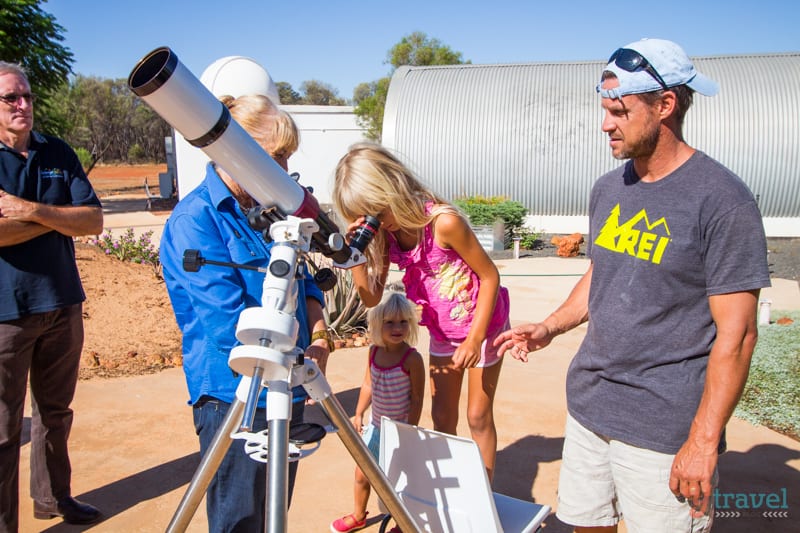
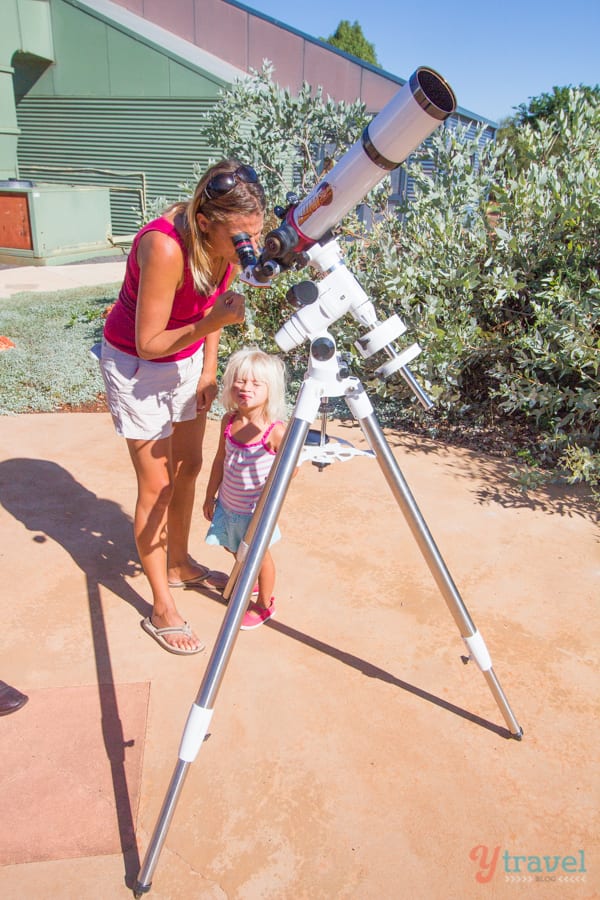
Don’t try this at home kids, but we also stared directly at the sun with our funky special glasses supplied by the Charleville Cosmos Centre.
This was certainly a unique experience, and something we never thought we’d be able to do given how dangerous it is to look directly at the sun.
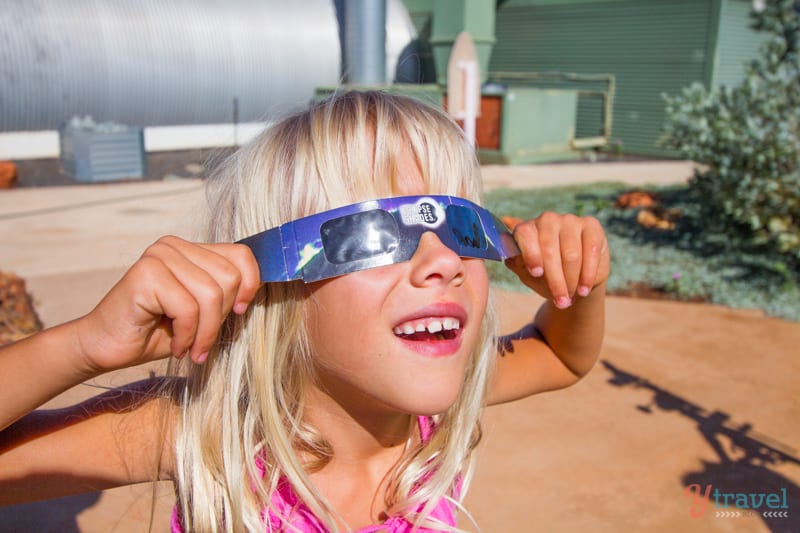
When you dive into astrology, your mind bends itself backwards and twists around until you’re lost and have zero comprehension of time and numbers.
The stars we saw through the telescope were millions of light years away.
When viewed through the telescope, these tiny sparkling dots to the naked eye were actually a cluster of millions of stars.
Millions of stars!!
It’s unbelievable.
It’s unnerving.
I can’t hear about outer space without a sinking feeling of emptiness and black fear.
We’re so small and so insignificant. We can be swallowed up by the blackness at any second. The questions swirl around me.
Why are we here? How can we be so small and so irrelevant? Who else is out there? How can this black space have no end?
I can’t get any answers, so I turn my bleakness over to wonder and gratitude. Even though minuscule, we are still apart of such perfect and mind-bending creation.
I slip back into staring through the telescope again with sheer joy.
I want to see more.
I look into the eyepiece to see the Sun and all I see is blood orange taking up the entire frame.
I look up to see if there is a cap on and then I realise what I’m looking at. I wasn’t expecting it to take up the entire frame and to be so close to it.
“Oh my God, it’s the Sun! And it’s so orange.”
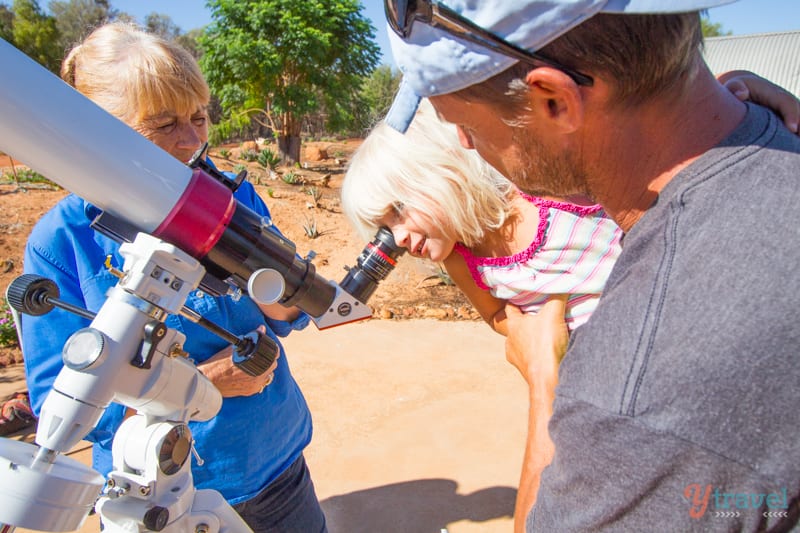
My eyes adjusted and soon the sun’s outline, with a thin ring of black around it appeared. Within the orange circle were black specks, otherwise known as sunspots.
Wispy strings danced around the edge of it. These tiny solar flares in reality can be as big as the earth. It was thrilling.
“That’s like one of the best things I’ve ever seen.”
We looked a couple more times, getting our fix before the Sun rose higher in the sky and became too intense for us to look at. I was in a euphoric daze for some time after.
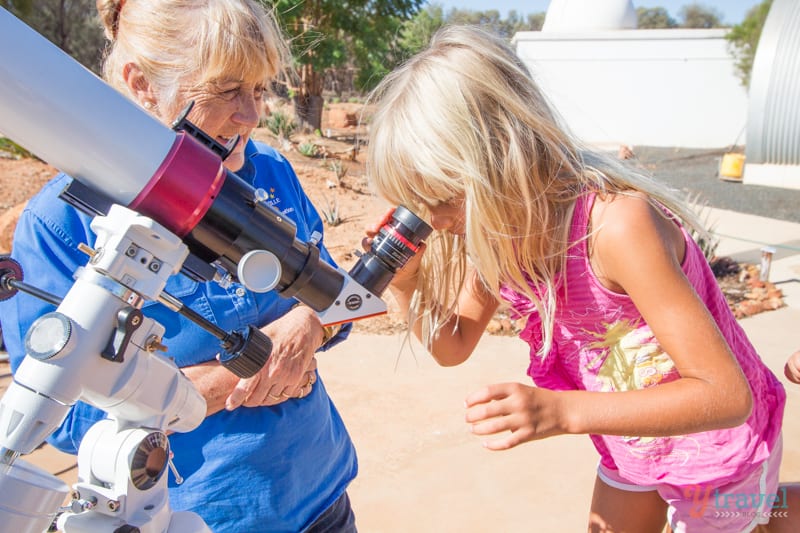
Planetarium and Information Zone
It was hard to concentrate on the interactive displays in the Information Zone inside.
My mind kept drifting back to the flares of a great ball of fire we worshipped going to bed almost every night.
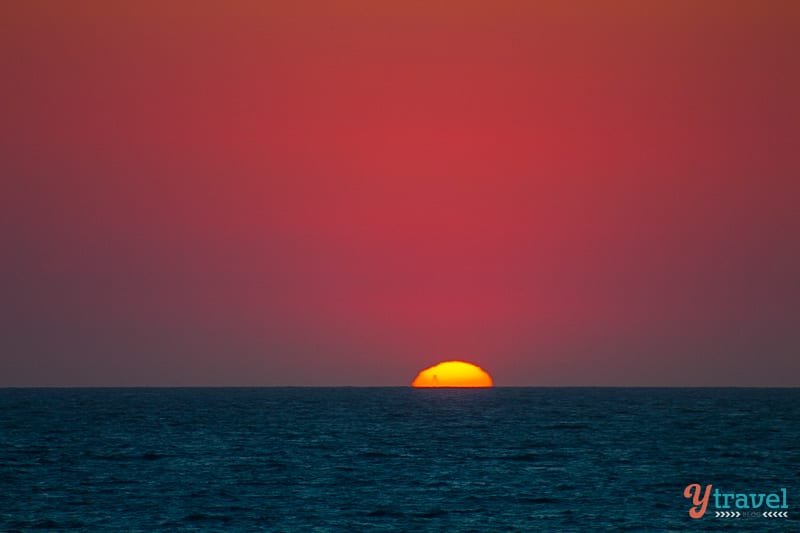
Back inside, there were lots of timeless stories and interesting facts for the kids to learn about space.
The centre is a state of the art facility and has lots of new, modern whizz-bang technology and interactive displays showcasing the expanse of the Cosmos and our galaxy.
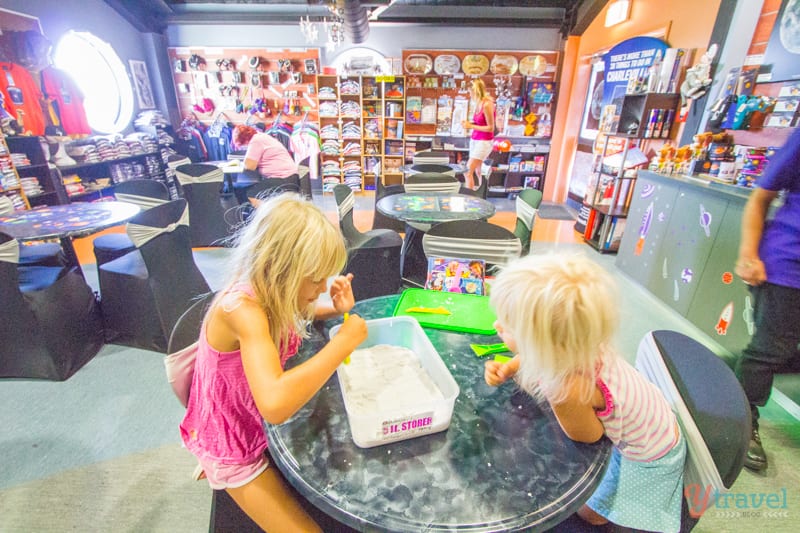
There’s plenty of signage and pictures that make the information easy to digest and understand.
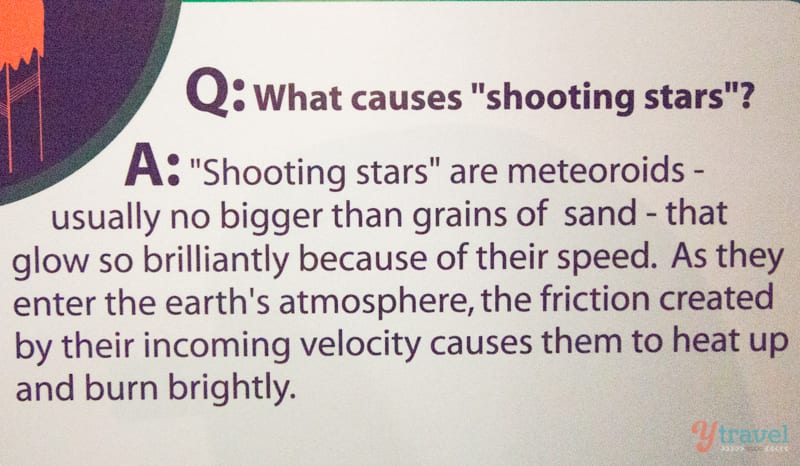
After a quick coffee break (kudos to the training barista – you nailed creamy deliciousness) complete with cute star in the froth, we got to hold a shooting star!
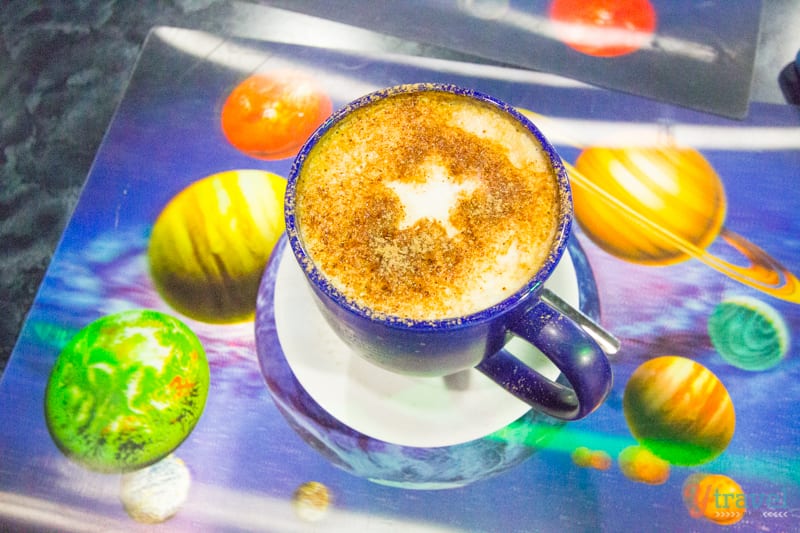
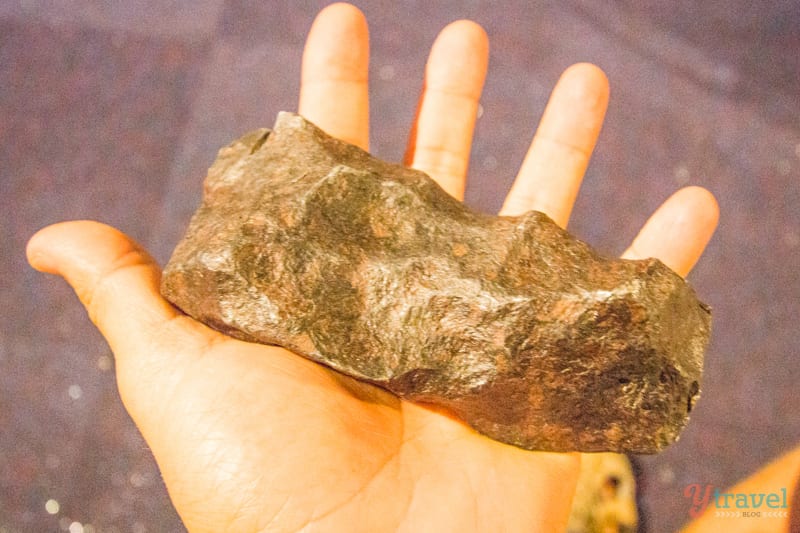
For reals.
Jane, our guide, captivated us with stories of meteorite crashes and we were allowed to touch a few of the outer space rocks.
I actually can’t believe how many meteorites hit the earth and I find it incredible we don’t hear more about them and more people don’t die.
It’s best that you don’t think about it much because, as Jane says, “they’re moving too fast to receive any warning.”
It was truly fascinating learning more about astronomy with Jane, and very educational for all of us.
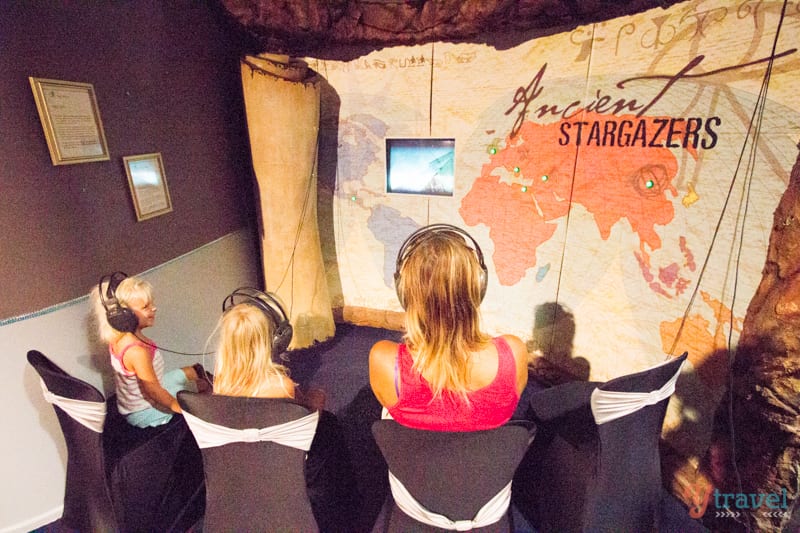
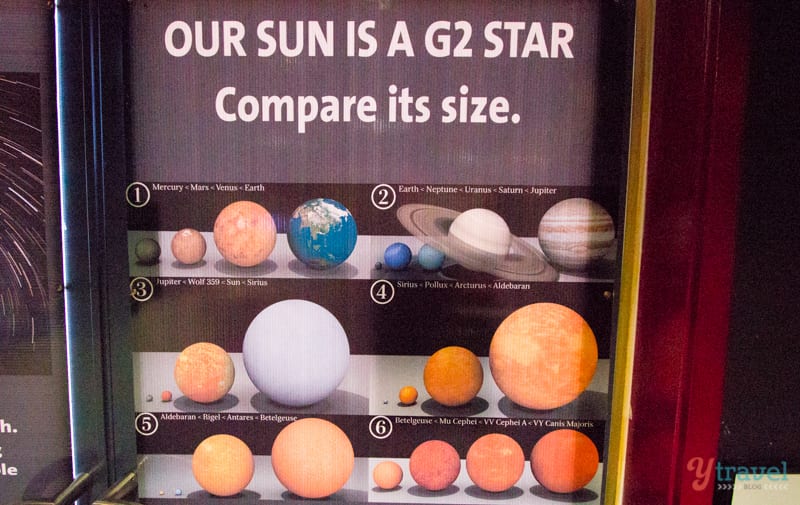
Observatory by night
The highlight in a day of highlights came later that evening when embarked on one of the observatory’s night experiences.

We looked at Jupiter, the wonder of the Outback night sky through giant telescopes in the outside observatory.

Kalyra will tell you the highlight was looking at the Jewel Box cluster, which is one of the brightest stars in the Southern Cross.
Except, it’s not one star it’s a cluster of about 50 sparkling, colourful stars. Named because it looks like a jewellery box that has spilled out its contents.

Craig will tell you that looking at the moon close up to see every single detail was something he’ll never forget.
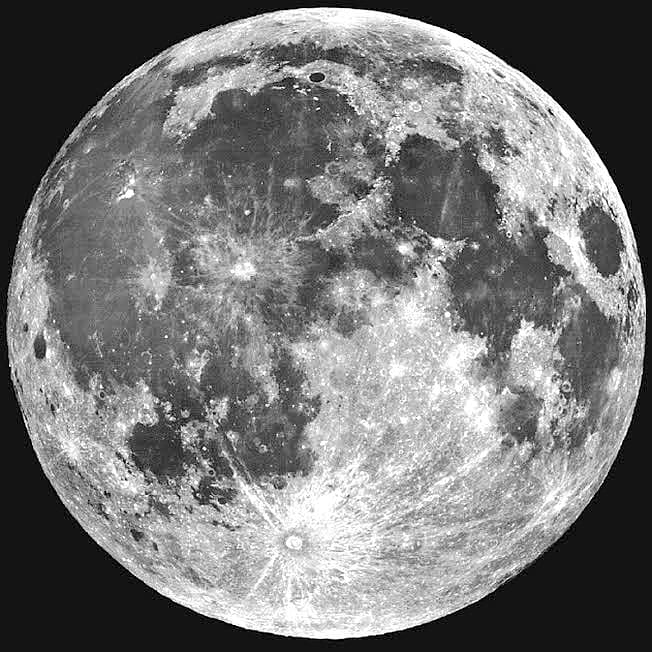
Savannah part agreed with him, and part agreed with me – for me, it was all about Jupiter.
It was the first time I’ve ever seen a planet outside of a textbook.
A perfectly round ball of gas, with black bands around its waist, not giving any indication of the constant cyclonic storm that rages around it.
It looked sleepy and calm, yet a strong and fitting protector. We could see four of its 63 moons standing guard around it.
It was mesmerizing.
And he became our talisman. Our guardian. The one we looked to each night as we shared our stories of the day we spent staring out into space, contemplating the enormity of the Universe and how we too are made of stardust.
Would We Recommend the Charleville Cosmos Centre?
We were unplugged from our business for our time in Charleville, and it was the first time on this trip we didn’t care.
We had the stars, the moon, the milky way, and Jupiter.
It was so beautiful to come across these words from Stephen Hawking about the beauty of looking up at the stars and contemplating:
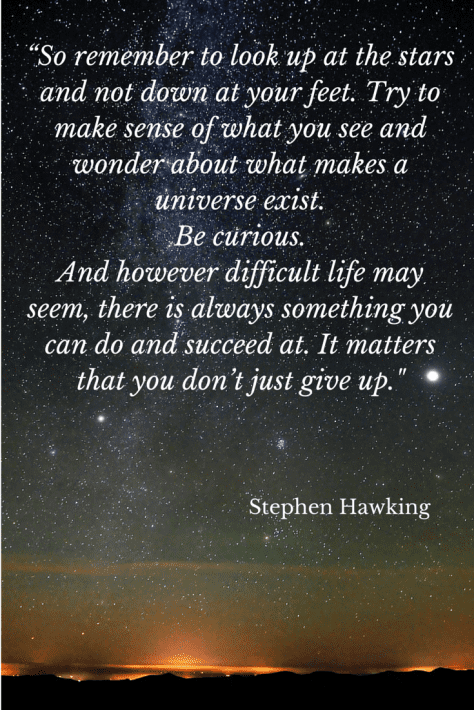
The Cosmos Centre was an unexpected treasure dished up to us in Outback Queensland, and we’d highly recommend it for families with young kids wanting to do something fun and educational.
Jane and Shelley, our guides, made astronomy and Aboriginal stories of the constellations interesting and easy to understand.
Shelley was so amazing with the girls, pointing out the stars to them and telling them stories. They adored her and still talk about her.


It gave Craig and I so much to think about and taught us more knowledge of astronomy than school ever did.
But the reason we loved it the most, was it gave our daughters so so much – a stirring of their curiosity and questioning, a chance to contemplate, a moment to think about potential and capabilities, and endless horizons that can never limit us.
They’ll never look into the sky any more and just see a sun, and a moon, and a bright shining star.
They see magic and possibilities.
It gave us an anchor to reconnect our bond on any evening we choose to look up and see Jupiter.
Other Things to Do in Charleville
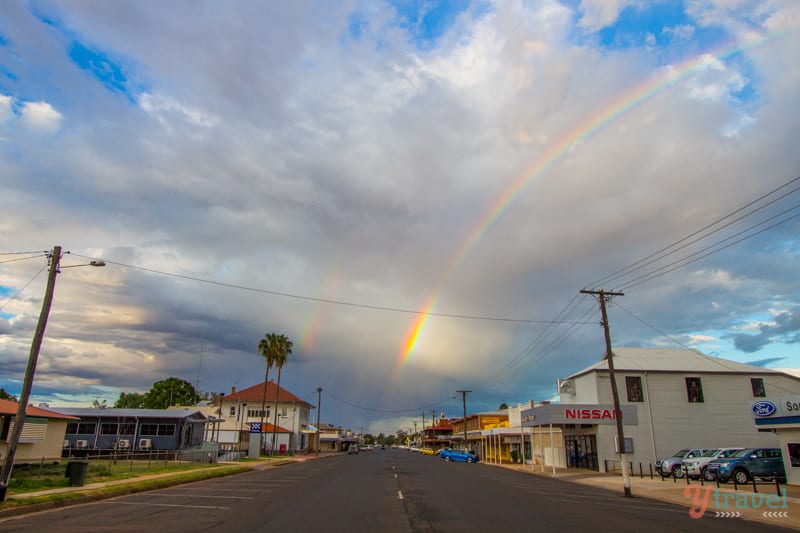
While you’re in Charleville, be sure to check out the following other activities.
Evening Star Campsite at Thurlby Station
I tell ya, the warm friendliness of Winton, Longreach and Mount Isa continued into Charleville.
Outback Queensland wins the award for warmest and most welcoming people in Australia.
We arrived at our campsite at Thurlby Station late at sundown and was greeted by the manager, Craig, with an ice cold beer in his hand for us.
“Don’t worry about dinner guys, I’ve grabbed some lamb chops for you. We’re going to have a barbie. The onsite managers are going to join us and so are the campers over there who are passing through for the evening. As soon as you’re set up come on over, I’ll start the fire pit.”
It was the biggest fire pit I’ve ever seen.
I could imagine how awesome it would be on a cool winter’s night – peak season for travellers – with guests sharing stories over a few drinks at the bar.
Craig, an anthropologist, shared with us quite a few Aboriginal spears and artifacts he’s found throughout his years as an avid researcher of their culture. It was a fascinating evening.
Evening Star Tourist Park is located on Thurlby Station 8km west of Charleville in the heart of Outback Queensland. Thurlby Station is a 33,000-acre working cattle station owned and operated by Col & Kristy Cornford.
This is a great place to unplug and unwind and be surrounded by the natural beauty of Outback Queensland.
Secret World War II History
Charleville has an important hidden World War II history.
During World War II, over 3,500 American Airbase slipped in, took over the airport and surrounding land and used it as a base for the B-17 bomber aircraft flown from the US to the South-West Pacific Area to fight the Japanese.
The remote airfield provided a safe haven for storage of valuable aircraft, the dry climate helping to minimise corrosion. The area was camouflaged by mulga tree branches and chicken wire.
It became an important place to store the TOP SECRET Norden Bombsight in a hidden vault, which you visit on the tour and see a genuine example of.
The Norden Bombsight would aid the crew of bomber aircraft in dropping bombs accurately.
The locals had no idea what was going on as everything had to be kept top secret.
They knew it was in the best interest for the war efforts and for the safety of everyone that no questions be asked.
Jane and some residents of Charleville have been uncovering many of the historic records and artifacts to piece together the events and stories of this time.
Not much can be found in official US military records. You can learn more about the war history in the area by joining a convoy tour organised and run by the Cosmos Centre.
Charleville Bilby Experience
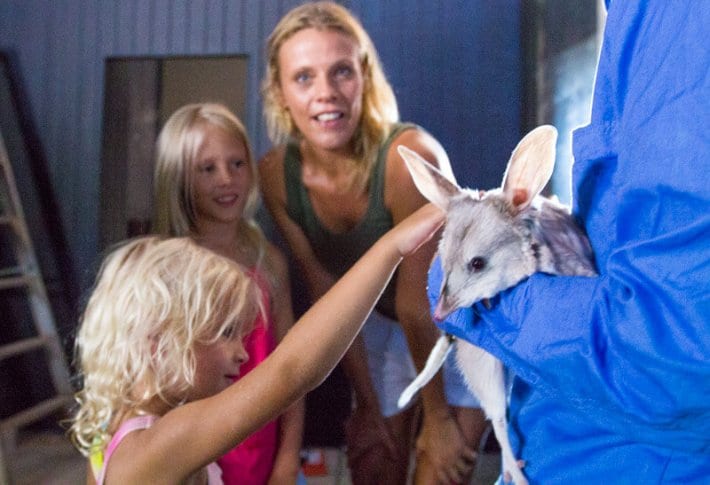
Bilbies are a small, nocturnal rodent-like animal that lives in the Outback, but their numbers are dwindling.
These native Aussie animals are said to be less than 10,000 left in the wild, so conservation practices such as the Charleville Bilby Experience are vital to keep them in existence.
The centre has a nocturnal house that’s been altered to look like night time, so you can see the bilbies during their night-time activities.
All proceeds go to the conservation efforts of these cute creatures.
Final Thoughts
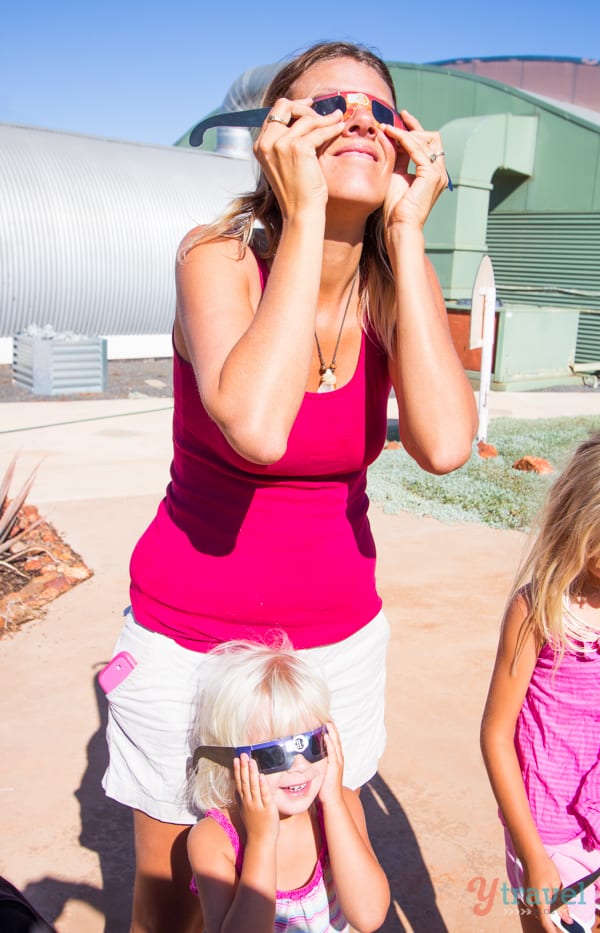
Many weeks later, Savannah comes running in from the balcony of our apartment on the Gold Coast after gazing intently above, exclaiming she has seen the moon.
It was a hobby we picked up on our road trip.
“What about Jupiter? Did you see that too?” Craig asked.
“Oh, wait a minute,” she raced back out and then back in.
“Yep. I saw Jupiter too, Mummy. Jupiter’s in the sky.”
My heart did a double flip at the memory of the evening we were introduced to Jupiter at the Charleville Cosmos Centre.
Every evening, after the night we spent star gazing at the Cosmos Centre in Charleville, we’d look up to find this powerful God of the Skies watching over us.
Craig has a fairly even temperament and doesn’t have extreme hyper “that was so awesome” celebration swings like I usually do. But, this star gazing thing got his hyper cheer raising loudly.
He even started talking about buying a telescope.
Kalyra’s questioning about supernovas and the sun dying still hasn’t stopped…
Are you thinking of visiting the Cosmos Centre Charleville? What are you most excited for? Let us know in the comments.
More Outback Queensland Travel Tips
Pin To Save On Pinterest
